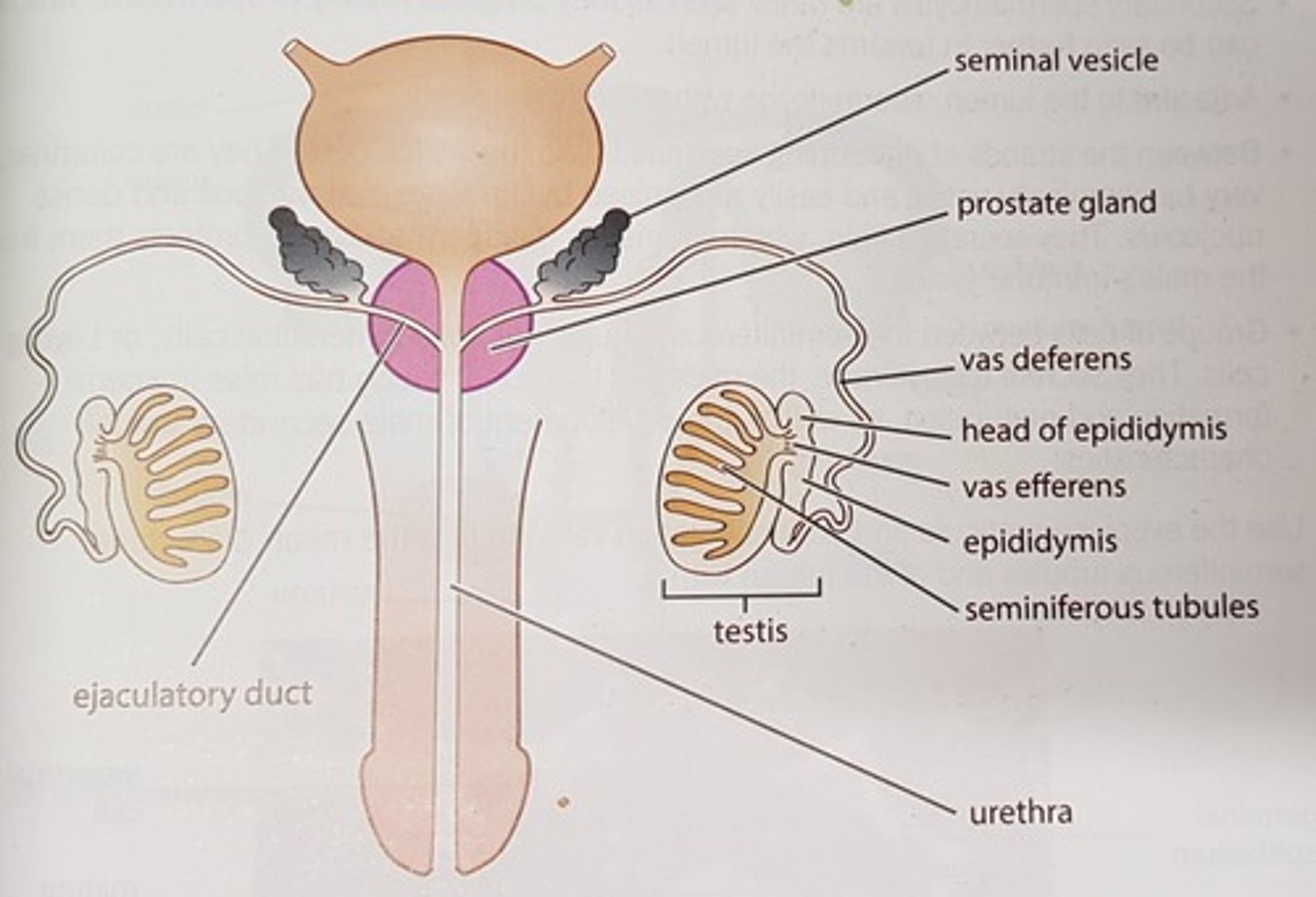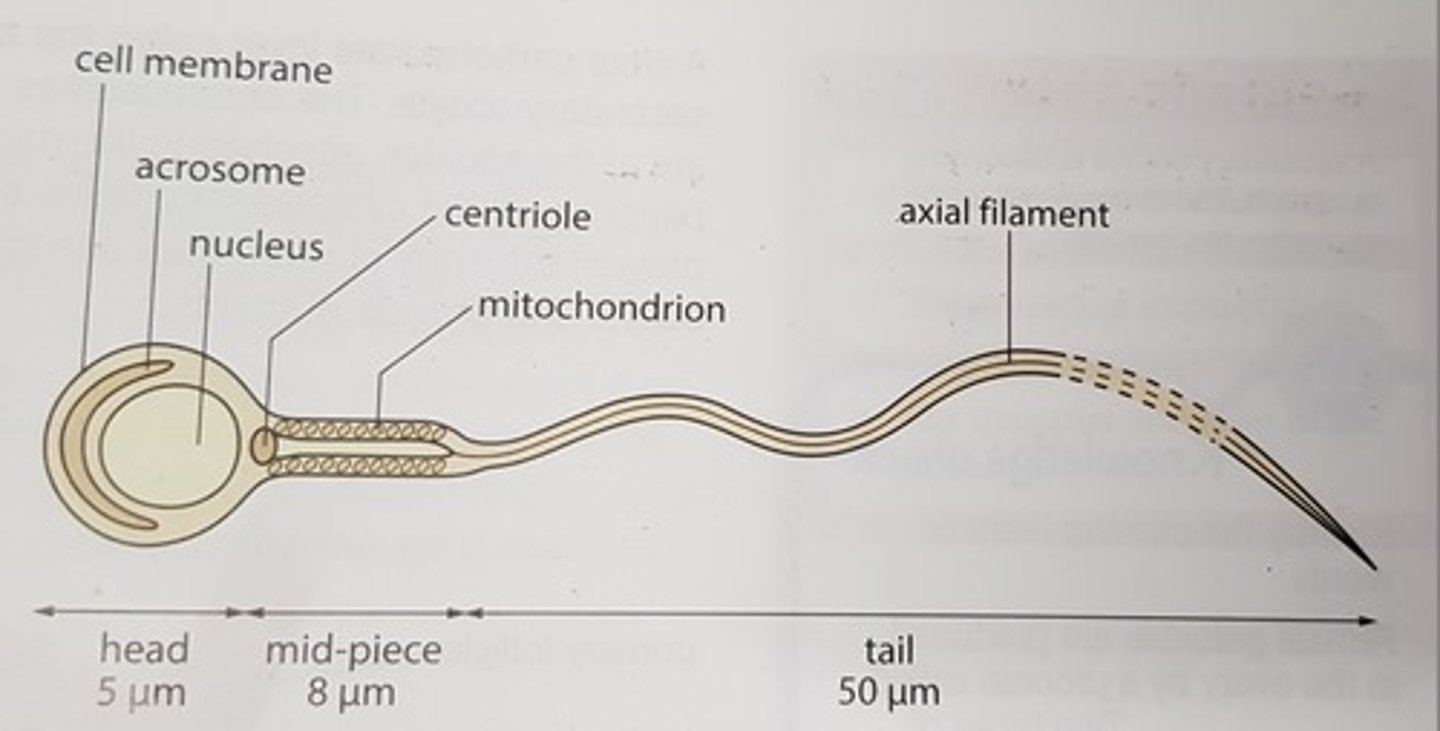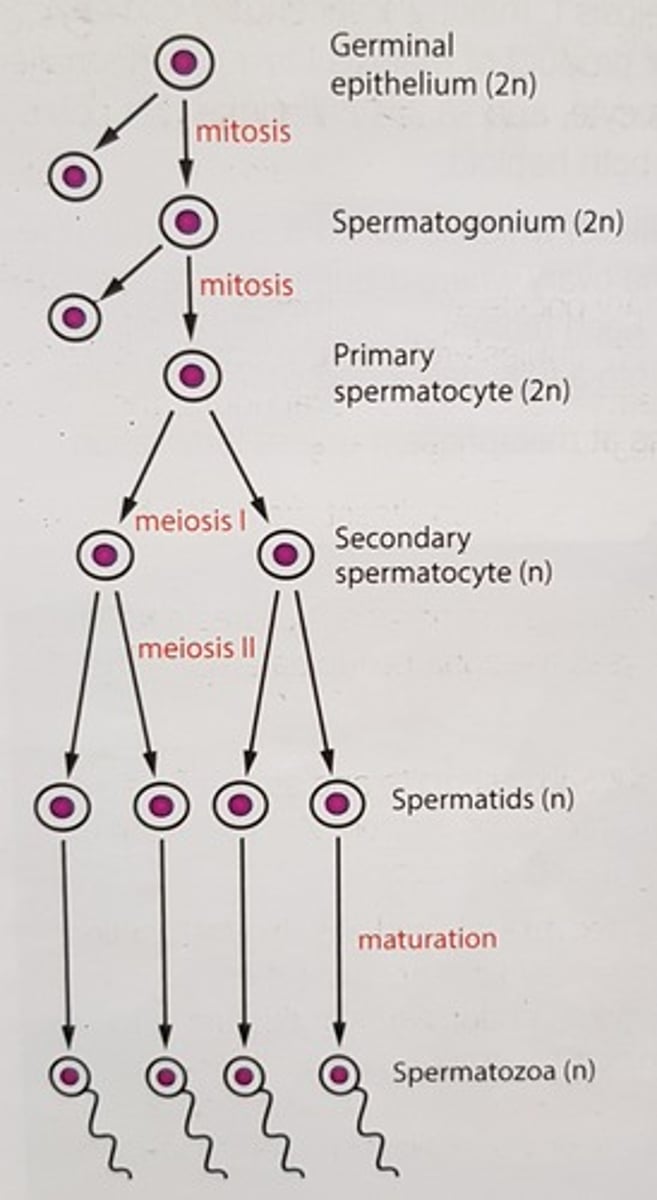Eduqas Biology A Level C2 - Sexual reproduction in humans
1/83
There's no tags or description
Looks like no tags are added yet.
Name | Mastery | Learn | Test | Matching | Spaced |
|---|
No study sessions yet.
84 Terms
Draw a labelled diagram of the male reproductive system
Must include: scrotum, testes, epididymis, vas deferens, seminal vesicle,
prostate gland, urethra, and penis

The seminiferous tubules are found in the...
testes
The seminiferous tubules are the site of...
spermatogenesis
The epididymis is found in the...
testes
What is the function of the epididymis?
Sperm are stored until they mature here
The vas deferens carry _________ to _________
sperm towards the penis
The seminal vesicles are located...
Near, but behind the bladder, above the prostate gland
What is the function of the seminal vesicles?
They secrete a mucus into the vas deferens which contains a mixture of chemicals including fructose
Why is it beneficial for the mucus secreted by the seminal tubules to have fructose?
Fructose is respired by the sperm for energy
Where is the ejaculatory duct located?
Withing the prostate gland, leading from the vas deferens to the urethra
Where is the prostate gland located?
below the bladder
What is the purpose of the prostate gland?
To secrete prostate fluid
What are the functions of the prostate fluid?
- Maintain sperm mobility
- Provide nutrients for the sperm, including fructose, amino acids and zinc ions
- Neutralise the acidity of any urine remaining in the urethra
- Neutralise the acidity of the vaginal tract
The fluid emerging from the prostate gland is called...
semen
Semen is a mixture of...
spermatozoa, seminal fluids and prostate fluids
What is the function of the urethra in the male reproductive system?
Carries urine and semen to the outside of the body
What is the function of the penis?
deliver sperm into the female reproductive tract
Define gametogenesis
production of gametes
Define spermatogenesis
Formation of sperm
Why is it important that gametes are haploid?
So when during fertilisation the diploid number is restored and the number of chromosomes does not double
The origin of spermatogenesis in the testes is ________ cells
germinal epithelium cells
Are germinal epithelium cells diploid or haploid?
Diploid
Germinal epithelium cells in the testes divide by mitosis to form...
spermatogonia and more epithelial cells
Germinal epithelium cells in the testes divide by _______ to form spermatogonia and more epithelial cells
mitosis
Are spermatogonia diploid or haploid?
Diploid
Spermatogonia divide many times by _______ to form primary spermatocytes and more spermatogonia
mitosis
Spermatogonia divide many times by mitosis to form...
primary spermatocytes and more spermatogonia
Are primary spermatocytes diploid or haploid?
Diploid
Primary spermatocytes undergo ________, making secondary spermatocytes
meiosis I
Primary spermatocytes undergo meiosis I, making...
secondary spermatocytes
Are secondary spermatocytes diploid or haploid?
Haploid
Secondary spermatocytes undergo _________, making spermatids
meiosis II
Secondary spermatocytes undergo meiosis II, making....
spermatids
How are spermatozoa made from spermatids?
Spermatids mature into spermatozoa
Are spermatids diploid or haploid?
Haploid
Are spermatozoa diploid or haploid?
Haploid
What is another word for spermatozoa?
sperm
Describe the process of spermatogenesis
- Diploid germinal epithelium cells in the seminiferous tubules divide by mitosis to make spermatogonia and more germinal epithelium cells
- The spermatogonia divide many times by mitosis, forming diploid primary spermatocytes and more spermatogonia
- Primary spermatocytes undergo meiosis I, making haploid secondary spermatocytes
- Secondary spermatocytes undergo meiosis II, making haploid spermatids
- Spermatids mature into spermatozoa/sperm
Draw a labelled diagram of a human sperm cell

Why do sperm cells have high numbers of mitochondria?
To provide lots of ATP for movement
What is the purpose of the axial filament?
It makes lashing movements that move the sperm
What is the purpose of the acrosome?
It contains enzymes that are used in fertilisation to break down the corona radiata cells of the oocyte
How many gametes are produced from one germinal epithelium cell in spermatogenesis?
4
Draw a flow cart to show the process of spermatogenesis from germinal epithelium cells to spermatozoa

Where are Leydig cells located?
between seminiferous tubules
What is the function of Leydig cells?
secrete testosterone
Where are sertoli cells located?
within the seminiferous tubules
What is the function of sertoli cells?
provide nutrients and protection to developing sperm
Draw a labelled diagram of the female reproductive system
Include: ovary, Fallopian tubes (oviducts), uterus, endometrium, cervix, and vagina

What is the innermost layer of the uterus wall?
the endometrium
What is the purpose of the endometrium?
It builds during the menstrual cycle in case an oocyte is fertilised, preparing for implantation
Define oogenesis
production of female gametes
Where does oogenesis occur?
In the ovaries, up to the production of secondary oocytes, and a small portion in the Fallopian tubes
Germinal epithelium cells in the ovary divide by _________ to make oogonia and more germinal epithelium cells
mitosis
Germinal epithelium cells in the ovary divide by mitosis to make...
oogonia and more germinal epithelium cells
Are oogonia diploid or haploid?
Diploid
Oogonia divide many times by ________, making primary oocytes and more oogonia
mitosis
Oogonia divide many times by mitosis, making...
primary oocytes and more oogonia
Are primary oocytes diploid or haploid?
Diploid
What happens to the primary oocytes made by mitosis of oogonia?
They begin to undergo meiosis I but stop until puberty
When does oogenesis first stop?
During meiosis I of the primary oocytes, in the developing foetus
In what stage of a biologically female's life cycle does the first part of oogenesis occur? (up to meiosis I of primary oocytes)
In the developing foetus
When does meiosis I of primary oocytes continue?
During puberty, when its completion is stimulated by hormones
What are the two products of meiosis I of a primary oocyte?
A secondary oocyte and the first polar body
When does oogenesis stop for the second time?
At metaphase II of the secondary oocyte, before fertilisation
When the secondary oocyte completes meiosis II (after fertilisation) what cell(s) are formed?
The second polar body and the ovum
Is the first polar body diploid or haploid?
Haploid
Describe the process of oogenesis, from germinal epithelium cells to the ovum (do not include follicle development)
- Diploid germinal epithelium cells divide by mitosis, producing diploid oogonia and more germinal epithelium cells
- The oogonia divide many times by mitosis to produce diploid primary oocytes and more oogonia
- The primary oocytes begin meiosis I but pause until puberty
- During puberty, the primary oocytes complete meiosis I and form haploid secondary oocytes and the first polar body
- The secondary oocyte begins meiosis II but stops at metaphase II until fertilised
- After fertilisation, meiosis II completes, forming an ovum and the second polar body
Describe the life-cycle of the follicle during oogenesis
- Germinal epithelium cells divide by mitosis to form diploid follicle cells
- These follicle cells surround the primary oocyte, forming the primary follicle
- During puberty, the primary follicle develops further into the secondary follicle as the secondary oocyte is formed
- Before ovulation, the secondary follicle matures into the Graafian follicle
- At ovulation, the Graafian follicle bursts, releasing the secondary oocyte
- After ovulation, the Graafian follicle becomes to corpus luteum
- If fertilisation occurs the corpus luteum produces hormones, and if not it regresses
Draw a flow diagram to show the process of oogenesis

What are the layers of a secondary oocyte, from the inside out?
cell membrane, zona pellucida and corona radiata
What are the 3 main processes that occur during fertilisation?
Capacitation, the Acrosome reaction, and the Cortical reaction
Capacitation
Changes in the sperm cell membrane that increase its fluidity and allow the acrosome reaction to occur
The acrosome reaction
The acrosome releases hydrolytic enzymes which digest the corona radiata and the zona pellucida, allowing the cell membranes of the sperm and oocyte to fuse
The cortical reaction
Fusion of cortical granule membranes with the oocyte cell membranes, releasing their contents, which convert the zona pellucida into a fertilisation membrane
What is the purpose of the fertilisation membrane?
It is impossible for more sperm to penetrate, so prevents polyspermy
Where does fertilisation occur?
In the Fallopian tube
Describe the process of fertilisation
- The sperm reaches the secondary oocyte
- Capacitation occurs, in which the cell membrane over the acrosome of a sperm increases in permeability
- The acrosome reaction occurs, during which the acrosome releases its hydrolytic enzymes. These enzymes break down the corona radiata and the zona pellucida
- Once the cell membrane of the oocyte is exposed the sperm cell membrane will fuse with it, releasing the head of the sperm into the cytoplasm
- Once one sperm has entered, the cortical reaction occurs, forming the fertilisation membrane and preventing more sperm from entering
- Meiosis II of the secondary oocyte completes, forming the ovum
- The genetic material of both the sperm and the ovum combine, making a zygote
Describe the process of implantation
- After fertilisation, the embryo moves down the Fallopian tube
- It divides many times by mitosis, in a sequence called cleavage, to form a blastocyst
- The blastocyst moves from the Fallopian tube to the uterus
- At the uterus, implantation occurs, where the blastocyst attaches and sinks into the endometrium
Define trophoblast
outer layer of cells in the blastocyst
Define implantation
The sinking of the blastocyst into the endometrium
What are the main roles of the placenta?
- It produces hormones to support the pregnancy
- Exchange between the mother's and foetus's blood
- A physical barrier between the maternal and foetal blood (protects the foetal capillaries from high blood pressure)
- Providing passive immunity to the foetus
- Protection from the maternal immune system
What is the function of the umbilical cord?
It transfers blood between the foetus and the maternal body
What are the 4 significant hormones of the menstrual cycle?
Follicle stimulating hormone (FSH), luteinising hormone (LH), oestrogen and progesterone